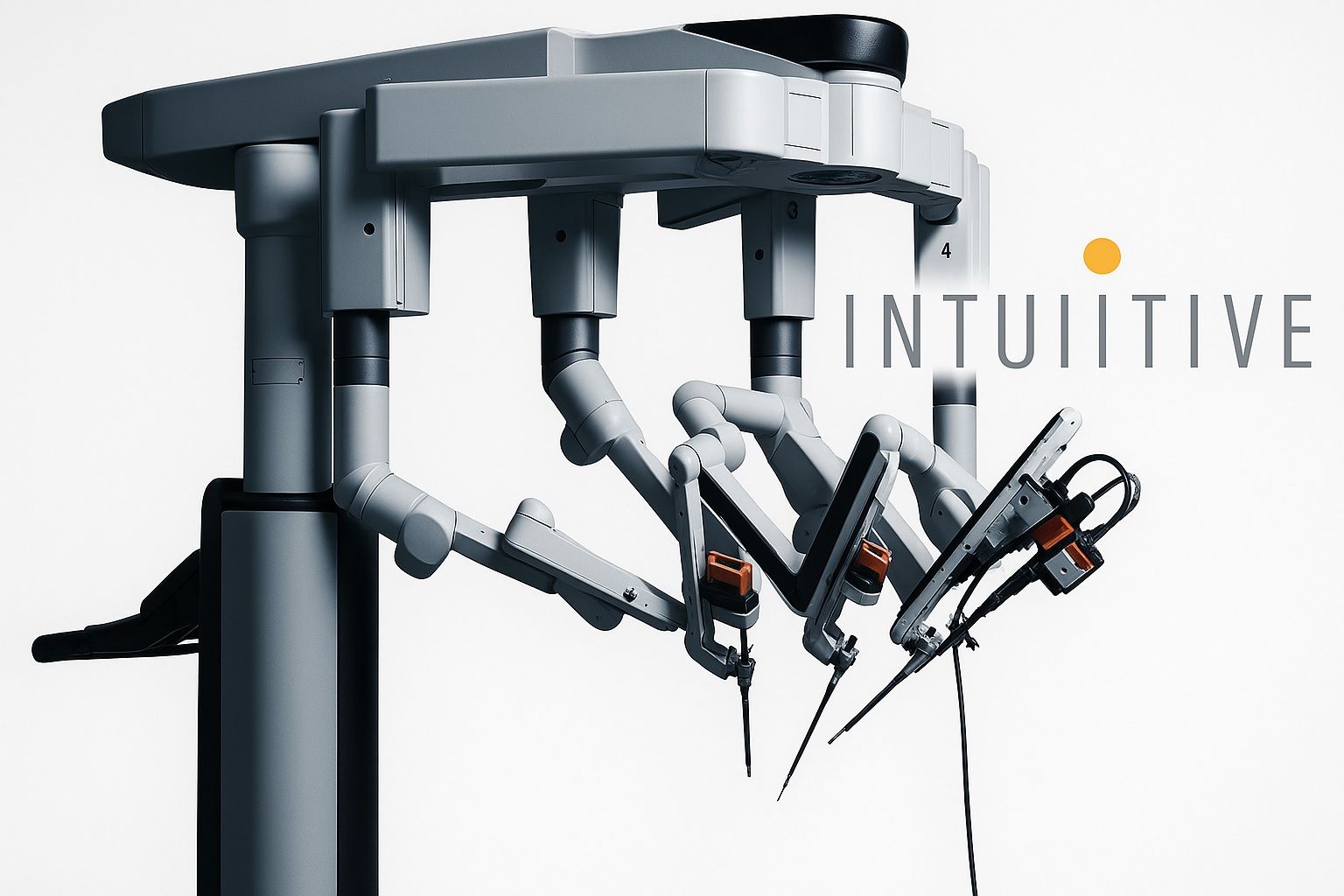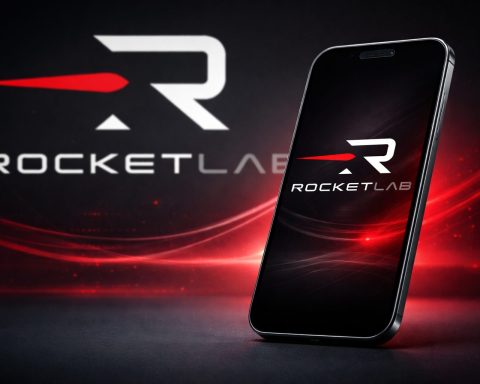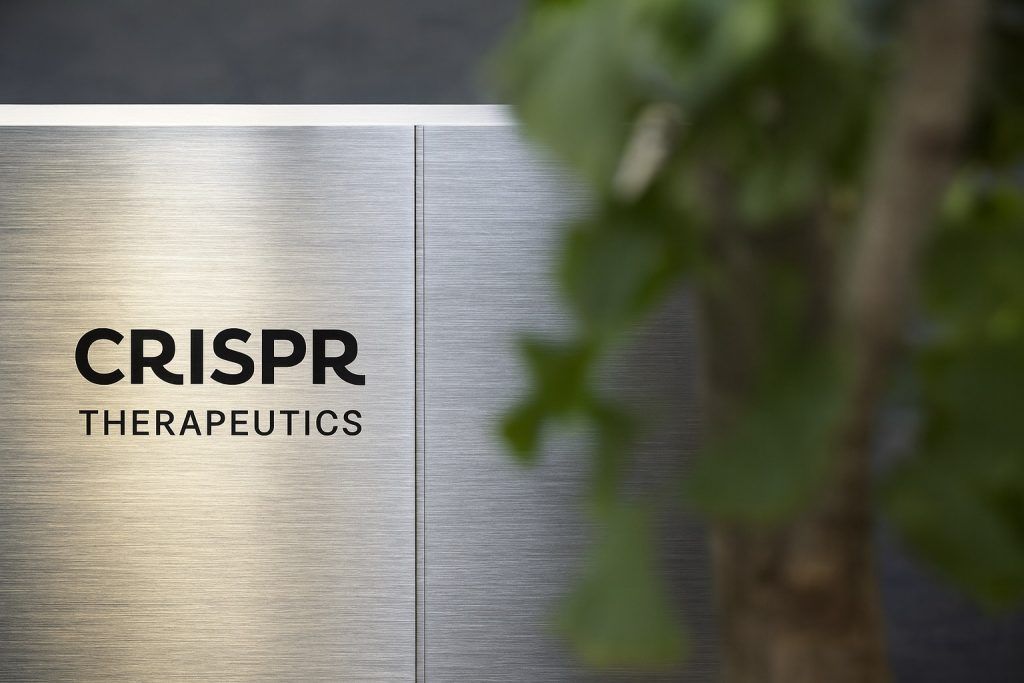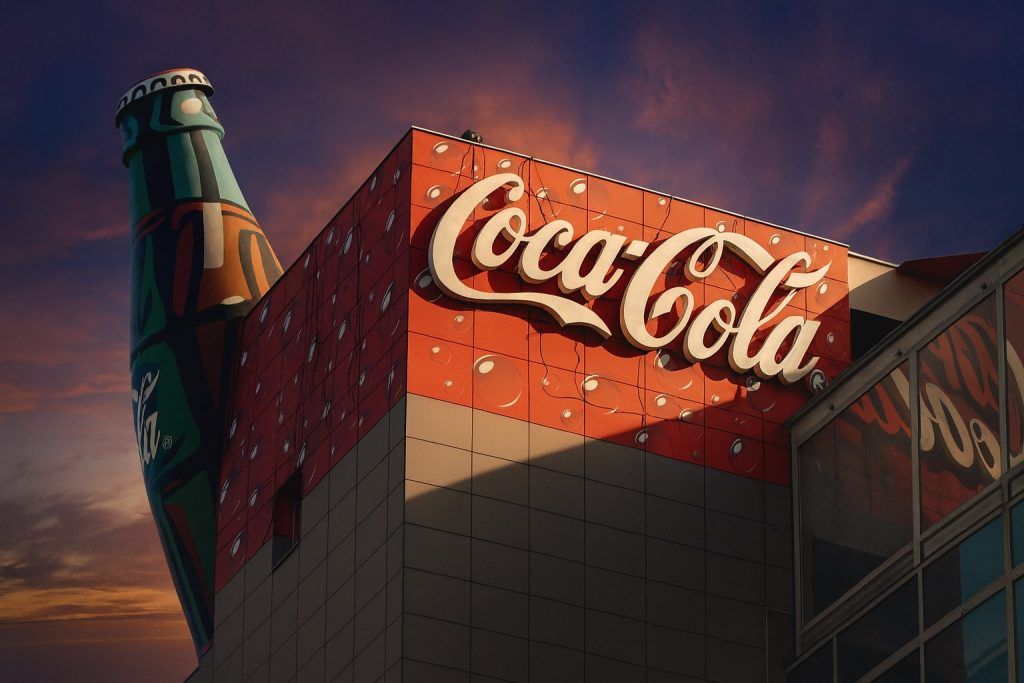- Stock Snapshot: As of Oct. 19, 2025, Intuitive Surgical (NASDAQ: ISRG) traded around $446 per share, near its 52-week low ($425) vs. high ($616) [1]. Analysts remain bullish – 22 rate ISRG a “Buy” (2 “Sell”) with an average 12-month target near $580 (roughly 30% above today’s price) [2] [3].
- Q2 Earnings Beat: In Q2 2025 ISRG grew sales 21% YoY to $2.44 billion and delivered GAAP EPS $1.81 (vs. $1.46 prior year) [4]. Global da Vinci surgical procedures rose ~17%, and Intuitive placed 395 new systems (including 180 of the new da Vinci 5 model) in Q2 (vs. 341 a year earlier) [5]. The installed base reached 10,488 robots (up 14% YoY) [6]. CEO Dave Rosa noted “continued customer adoption of our newer and existing platforms, including da Vinci 5” [7].
- Growth Catalysts: Adoption of the da Vinci 5 upgrade and recurring sales of consumables/services are driving growth [8] [9]. Key regulatory wins have expanded Intuitive’s addressable market: in mid-2025 it secured EU MDR certification for da Vinci 5 (adult and pediatric use) [10] and Japan clearance for da Vinci 5 across most indications [11]. In October 2025 the FDA approved new AI-powered navigation/imaging software for its Ion robotic bronchoscopy platform [12], enhancing lung-biopsy procedures. These upgrades – along with advanced da Vinci 5 features like force-feedback and video replay – should bolster utilization and recurring revenue [13] [14].
- Analyst Sentiment: Wall Street expects Intuitive to report strong Q3 results (Oct. 21): Zacks projects about $2.41B in sales and $1.99 EPS for Q3 [15]. Consensus remains positive (average price targets ~$576–$582) [16] [17]. Notably, Truist recently cut its ISRG target to $525 (still a 20% upside) while maintaining a Buy rating [18]. Broadly, analysts see double-digit upside from current levels and emphasize Intuitive’s recurring-revenue model. Zacks assigns ISRG a neutral Rank (#3) as of mid-Oct, noting a slightly negative earnings‐surprise history and ongoing tariff/capex headwinds [19] [20].
- Investor Buzz: Interest has spiked ahead of earnings. For example, several U.S. Congress members bought ISRG shares in recent months – a signal highlighted by MarketBeat as a bullish sign [21]. Insider activity has also been notable (with CEO Gary Guthart selling ~29k shares in summer). Despite the stock’s recent pullback (~30% from its spring high) [22], long-term investors point to Intuitive’s 25-year history of market leadership in surgical robotics [23] and its “high switching-cost moat” (over 11,000+ da Vinci installations worldwide) [24].
Stock Performance & Analyst Consensus
Intuitive’s stock has been volatile in 2025. It gained ground last week on optimism (e.g. up ~2.7% on Oct. 17) and now sits around $446 [25] [26]. Over the past year, the price swung between about $425 and $616 [27]. At ~$446, ISRG trades at a high single-digit P/E (~60x) compared to the medtech sector, but analysts argue much of Intuitive’s growth is already priced in. Institutional sentiment is upbeat: 22 of 32 surveyed analysts rate ISRG a Buy, with an average 12-month target of roughly $576 [28] (implying ~29% upside). For example, RBC Capital recently reiterated an “Outperform” rating with a $615 target, and Truist maintains a Buy (albeit with a trimmed $525 target) [29]. MarketBeat’s consensus is ~$582 [30], and simplywall.st’s fair-value model arrives at ~$582 as well (about 36% above the current price) [31].
Fundamentals are strong: Intuitive’s revenue has grown steadily (driven by higher procedure volumes and pricing), and its long-term EPS growth (CAGR ~16% over the last decade) is among the best in medtech. The company carries a pristine balance sheet ($9.5B cash) and has approved $3–4B in buybacks over time. Key risks include international tariffs (Intuitive forecasts these will shave ~1% off 2025 gross margins) [32] and potential hospital CapEx pullbacks. But with interest in robotic surgery rising globally, most Wall Street models still assume double-digit revenue growth through 2026.
Q2 ‘25 Earnings & Growth Drivers
Intuitive’s Q2 2025 report (July 22) highlighted robust growth across the board [33]. Revenue jumped 21% YoY to $2.44B, handily exceeding analysts’ forecasts. On a GAAP basis net income was $658M ($1.81/share) versus $527M ($1.46) in Q2 2024 [34]; non-GAAP EPS was $2.19 (vs. $1.78) [35]. Instruments & accessories (consumables) sales climbed 18% YoY to $1.47B, driven by 17% higher procedure volume [36]. Intuitive attributed this to broader adoption of the SP (“Single Port”) and new da Vinci 5 instruments. System sales were also strong: Q2 systems revenue hit $575M (vs. $448M a year earlier) as Intuitive sold 395 robots, of which 180 were da Vinci 5 systems [37]. (By comparison, Q2 2024 had 341 systems, 70 of which were da Vinci 5.) Importantly, procedures grew ~17% globally [38], and the installed da Vinci base is now 10,488 units (up from 9,203 a year ago) [39].
CEO Dave Rosa emphasized that “continued customer adoption of our newer and existing platforms, including da Vinci 5” was key to the quarter [40]. Indeed, Motley Fool notes that the da Vinci 5 rollout is “off to a strong start” – 180 units in Q2, up from 70 a year ago, with a full launch expected by year-end [41]. As Intuitive focuses on recurring revenue, its consumables and services segment now makes up the majority of sales [42]. For example, TS2.tech highlights that the company’s “key driver is shifting from robot sales to consumables and services” [43]. This provides a more predictable revenue base since each installed robot generates ongoing parts, instruments and service revenue over time.
However, management noted some headwinds: growth in bariatric (weight-loss) surgeries remains soft, and global CapEx budgets in healthcare are under pressure. Additionally, CEO Rosa reiterated that existing trade tariffs (on Chinese exports) could knock ~100 basis points off full-year margins [44]. The company updated its 2025 guidance: it now forecasts 15.5–17% growth in worldwide da Vinci procedures [45] and a non-GAAP gross margin of ~66–67% (down from 69.1% in 2024, due partly to tariffs) [46]. This implies Intuitive sees continued strong volume growth even as pricing pressure mounts.
New FDA Approvals and Global Expansion
Several recent product and regulatory milestones have boosted Intuitive’s outlook. In July 2025, Intuitive announced EU Medical Device Regulation (MDR) certification for the da Vinci 5 system (covering adult and pediatric use) [47]. Japan’s regulatory agency likewise cleared da Vinci 5 for virtually all surgical indications in June [48]. On the technology front, Intuitive released advanced da Vinci 5 software: features like a Force Gauge (providing haptic feedback) and an in-console video replay have been FDA-cleared. These tools improve surgeon control and training, and the FDA explicitly green-lit an update allowing surgeons to “review parts of a procedure while it is still underway” [49].
Perhaps most notably, the FDA in October 2025 cleared new AI-driven imaging and navigation software for Intuitive’s Ion lung-biopsy robot [50]. Simply Wall St reports that the cleared enhancements – which include real-time imaging updates and AI workflow guidance – should make lung cancer diagnostics more precise and efficient [51]. This could accelerate adoption of the Ion platform worldwide. Combined with regulatory progress (and Intuitive’s August FDA approvals for other software features), these wins have significantly expanded Intuitive’s addressable market [52] [53].
These developments have not gone unnoticed by investors. MarketBeat notes that with “new FDA approvals and a green light for European expansion, Intuitive now has access to a much larger, more actionable customer base” [54]. In practice, that means hospitals in Europe, Japan and elsewhere can sell and implant the latest da Vinci 5 robots and expanded Ion systems, driving sales outside the U.S. The consensus view is that these approvals should start appearing in the revenue and guidance in coming quarters (Q4 ’25 and beyond). For now, they underpin the bullish thesis: Intuitive isn’t just a medical device seller, but a technology leader in minimally invasive surgery with a fast-growing pipeline.
Competition Heats Up in Surgical Robotics
Intuitive Surgical long held a near-monopoly on high-end soft-tissue robotics, but competition is intensifying. Large medtech rivals are aggressively developing their own robot systems. Medtronic (MDT) is on the verge of entering the U.S. market with its Hugo platform: positive trial data in urology and hernia repair have been reported, and the FDA is reviewing Hugo for a urology indication [55]. Medtronic expects to launch Hugo in the U.S. (likely for urology first) by late FY2026 [56]. SS Innovations, CMR Surgical (CMR), Moon Surgical and others also have upcoming products targeting similar procedures. Even Johnson & Johnson – via its Ottava and Monarch initiatives – is positioning itself in robotics. Industry analysts note that “in 2025 Intuitive Surgical’s da Vinci will face growing competition from MedTech rivals (Stryker, Medtronic, Johnson & Johnson)” [57].
Despite the rising competition, Intuitive retains a massive lead. As of Q2 it had over 10,488 active da Vinci systems in 74 countries [58] – a base far larger than any rival has achieved. TS2.tech emphasizes that Intuitive “dominates robot-assisted surgery” and benefits from high switching costs, since hospitals invest heavily to train staff on a given platform [59]. In practice, most surgeons stick with da Vinci once trained. Still, investors will be watching how competitors gain share. For example, Motley Fool reminds readers that a successful da Vinci 5 rollout (Force Feedback & all) is crucial: “the launch is off to a strong start,” it notes, but new rivals make Intuitive’s path “less certain than it used to be.” [60].
On the positive side, Intuitive’s moat is widening in other ways. The company is integrating AI and analytics into its surgical systems and digital services – a strategy that competitors are only starting to match. In short, while peers (Medtronic, Stryker, J&J) push hard, Intuitive’s product lead, massive install base and recurring revenue from consumables give it a durable advantage [61] [62]. In any case, investors should watch industry news closely: recent coverage highlights frequent FDA updates and trials by both Intuitive and its challengers [63] [64].
Outlook and Forecasts
With Q3 earnings due Oct. 21, Intuitive Surgical is in focus. Most Wall Street forecasts call for continued double-digit growth: Zacks, for example, pegged Q3 sales at ~$2.41B and EPS at $1.99 [65]. Management’s full-year 2025 guidance (15.5–17% procedure growth) suggests similar or slightly slower rates in coming quarters. Analysts note that Intuitive beat expectations in four straight quarters (14% average EPS surprise) and remains on track to beat again [66]. In recent notes, some experts have modestly tightened their targets (e.g. Truist to $525, Goldman to $567), likely reflecting market volatility and tariff concerns [67] [68]. But the long-term picture remains bright: consensus 2026 EPS is around $9.17 [69], implying ISRG trades at ~50x forward, which many deem justified by growth.
Looking beyond a quarter, Intuitive’s self-reported outlook is optimistic. The company expects global da Vinci procedures to grow ~15.5–17% in 2025 [70] (down from 17% in 2024), and it sees operating-expense growth in line (10–14%). Wall Street surveys reveal robust targets: the average analyst sees ISRG reaching mid-$500s per share within 12 months [71]. Simply Wall St’s model projects ~$13.4B in revenue by 2028 (from ~$6.5B now) and EPS around $3.7B, yielding a “fair value” near $582 [72]. Even if growth slows post-2026, the combination of recurring revenue and high barriers to entry keeps many bullish.
In summary, Intuitive Surgical’s stock carries a Moderate Buy consensus. The company has beaten expectations and expanded its product pipeline, but remains priced for perfection. Upcoming catalysts (Q3 report, any further regulatory news, tariff developments) will influence short-term moves. Investors are split between focusing on near-term risks (tariffs, competition) and long-term strengths (technology leadership, loyal installed base). For now, the prevailing view is cautious optimism: Intuitive is “primed for a breakout” heading into earnings [73], but much will depend on execution.
Sources: Company filings and press releases [74] [75]; analyst reports and forecasts [76] [77]; financial news coverage [78] [79]; industry analysis [80] [81]. All data is current as of market close on Oct. 18, 2025.
References
1. www.investing.com, 2. www.investing.com, 3. www.marketbeat.com, 4. www.globenewswire.com, 5. www.globenewswire.com, 6. www.globenewswire.com, 7. www.globenewswire.com, 8. www.globenewswire.com, 9. ts2.tech, 10. www.globenewswire.com, 11. www.globenewswire.com, 12. simplywall.st, 13. www.globenewswire.com, 14. simplywall.st, 15. www.nasdaq.com, 16. www.investing.com, 17. www.marketbeat.com, 18. www.marketbeat.com, 19. www.nasdaq.com, 20. www.globenewswire.com, 21. www.marketbeat.com, 22. ts2.tech, 23. www.nasdaq.com, 24. ts2.tech, 25. www.investing.com, 26. www.marketbeat.com, 27. www.investing.com, 28. www.investing.com, 29. www.marketbeat.com, 30. www.marketbeat.com, 31. simplywall.st, 32. www.globenewswire.com, 33. www.globenewswire.com, 34. www.globenewswire.com, 35. www.globenewswire.com, 36. www.globenewswire.com, 37. www.globenewswire.com, 38. www.globenewswire.com, 39. www.globenewswire.com, 40. www.globenewswire.com, 41. www.nasdaq.com, 42. ts2.tech, 43. ts2.tech, 44. www.globenewswire.com, 45. www.globenewswire.com, 46. www.globenewswire.com, 47. www.globenewswire.com, 48. www.globenewswire.com, 49. www.medtechdive.com, 50. simplywall.st, 51. simplywall.st, 52. www.marketbeat.com, 53. simplywall.st, 54. www.marketbeat.com, 55. www.medtechdive.com, 56. www.medtechdive.com, 57. ts2.tech, 58. www.globenewswire.com, 59. ts2.tech, 60. www.nasdaq.com, 61. ts2.tech, 62. ts2.tech, 63. www.medtechdive.com, 64. www.medtechdive.com, 65. www.nasdaq.com, 66. www.nasdaq.com, 67. www.marketbeat.com, 68. www.marketbeat.com, 69. www.nasdaq.com, 70. www.globenewswire.com, 71. www.investing.com, 72. simplywall.st, 73. www.marketbeat.com, 74. www.globenewswire.com, 75. www.globenewswire.com, 76. www.nasdaq.com, 77. www.marketbeat.com, 78. www.marketbeat.com, 79. simplywall.st, 80. ts2.tech, 81. ts2.tech







